|
Link to a
Beneteau 35 being launched |
Launching on Travis
big trailers big trucks
long ropes
extremely skilled labor
caution
Payment Policies |
Link to an Islander 30 being launched |
| First we need a really long ramp. This ramp at the Mansfield
dam Park is about four lanes wide. The top of the ramp is at 685 feet above
sea level. The bottom of the ramp is at 635 feet above sea level. In this
photo the Lake is at about 660 feet above sea level. |
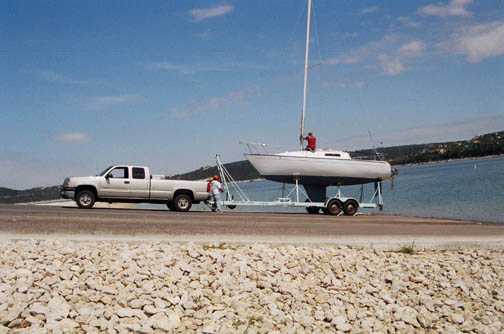 |
We have just finished raising the mast and driving the boat
from the rigging area to the ramp. The trailer ladder is too far from the
boat for Richard to safely climb down. The extension ladder is unsafe
on a tilted surface. Richard is riding on the boat. Alfonzo and Fred
are on the ground. |
| This rope is VERY important. fresh bottom paint, especially
the Teflon impregnated coatings, can be very slippery. We do not want the
boat to slide off until it is floating. |
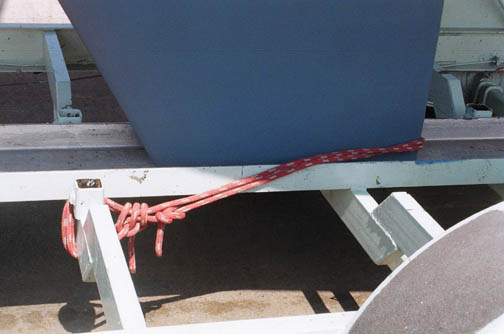 |
This 7/16 inch rope is nearly new and wrapped twice before
being tied with lots of overkill and unnecessary extra half hitches. It is
carefully tied so it will not do anything unless the boat slips. It is
absolutely tied so the keel cannot slide over it.
Paranoia can be a great thing when the goal is NEVER having a
disaster.
We will sink the trailer until the boat floats over the rope. |
| We have chocked the trailer wheels. |
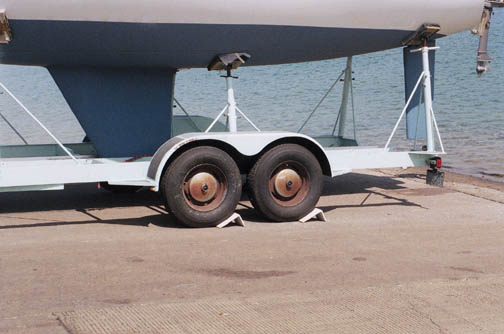 |
It is important to chock all four wheels as the trailer is
designed to "walk over" lumpy roads. We don't want the trailer to jump the
chocks. |
| We have disconnected the trailer and pulled the truck up the
ramp. |
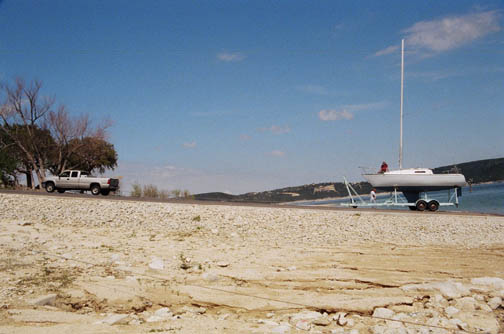 |
|
| Alfonzo is cranking the tongue down. The truck hitch is
rather high. The tongue jack was almost fully extended when the trailer
finally lifted over the ball. He had a lot of cranking to do and
by the time I took this photo he was almost done. |
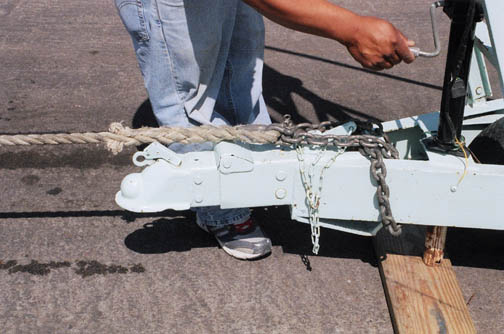 |
|
| The tongue is now sitting on our big launching wheel. It is
designed to help the trailer to roll in a straight line. We have
removed the 2 x 6. It is important that the trailer tongue be very low
because the ramp is slanted. When the back of the boat begins to float, the
keel is lifted from the keel support and the entire front end of the boat
will be supported above level by the front pads. |
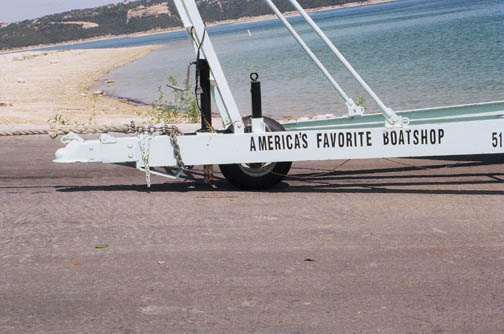 |
On a small boat like this San Juan 7.7 and with the
trailer tongue well down this is not an issue.
On 40 foot boats, the trailer must be adjusted and the front pads must be
lowered as the boat is lifted by the lake or the front pads will stress or
even do severe damage to the front of the hull. |
| The rope is attached to the truck with this simple chain and
splice system.
When we back up, the chain sags below the hitch and the connection
does not end until we physically lift the chain free.. |
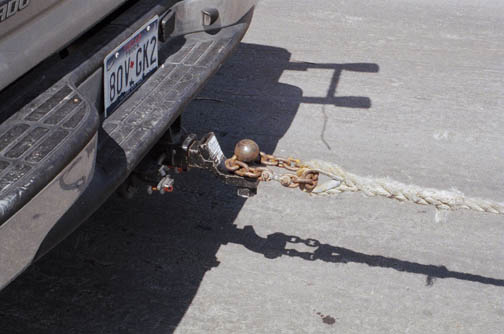 |
We do not use the rope itself to fasten to the ball because
the rope is quite stiff. Sometimes a 1 inch nylon rope is stiff enough that
it can have a mind of its own.
A friend of ours had her J-22 launching rope lift off the ball and her
trailer rolled about 100 feet back on the submerged ramp. We don't want to
repeat that mistake.
|
| Alfonzo is going to ride to the marina with Richard. This
boat stays at Marshall Ford Marina. which is in the background. Actually you
can only see the opening to the cove. The southwest side of the cove is just
above Richard's head. Marshall Ford / Quinlan Park is behind the forestay. |
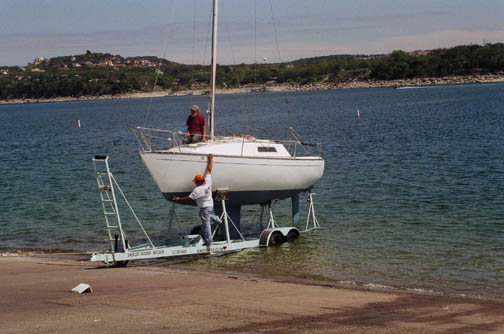 |
|
| Too bad this part was not a video. That step Alfonzo just
took from the trailer to the gunwale is huge. |
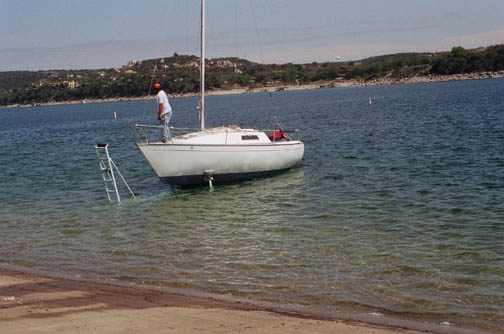 |
|
| Notice how deep the ladder is sunk. We not only try to clear
the keel safety rope but we like to sink the pads below the keel.
We back off as slowly as possible but the trailing edge of most sailboat
keels is fragile. The carpeted plywood pads are relatively forgiving but
contact with any of the steel trailer supports can do harm to the soft lead
and paints. |
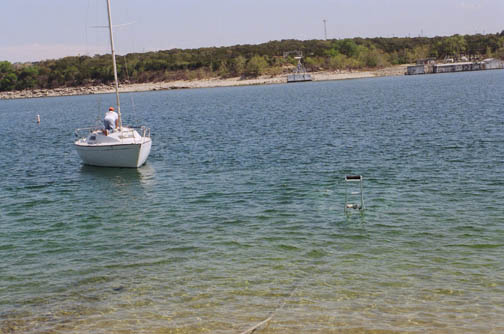 |
Soaking the trailer in six or more feet of water means lots
of expensive maintenance.
Every moving part needs regular cleaning, inspection, and lubrication.
There are the obvious five wheels with bearings. Tires cost over $160
each.
The hull supports have regularly lubricated 1 1/2 inch all thread screw
jacks.
|
| The fresh wet trailer is chocked.
The horizon is real. It looks like the bow of the 7.7 had to endure being
lifted at least a foot by our front pads.
That lift on our big soft carpeted pads did not harm the boat but we
wouldn't want to use square pads to lift that bow much higher. |
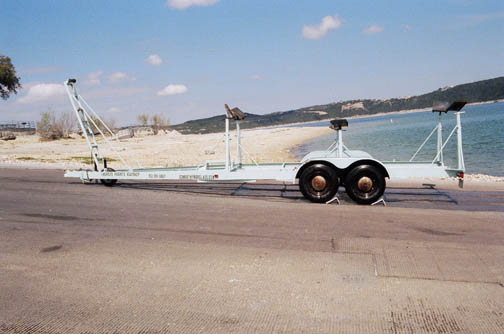 |
The adjustable pipes have four carefully lubricated pinch
bolts on each socket. The ladder is fully adjustable, but only if the nuts
and bolts can be moved.
The lights must work, the trailer must be regularly
inspected, sanded and repainted where rust is found.
The carpet lasts less than a year. |
| These sticks have magnets on the ends |
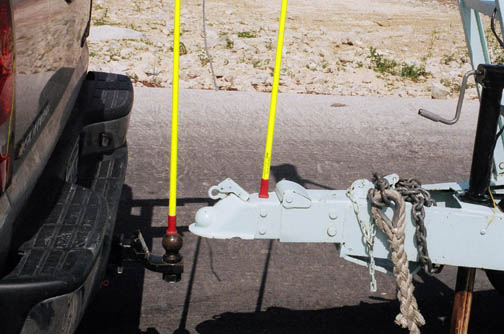 |
|
| The rear view mirror has this view. All I need to do is back
up slowly and knock the stick off the ball. |
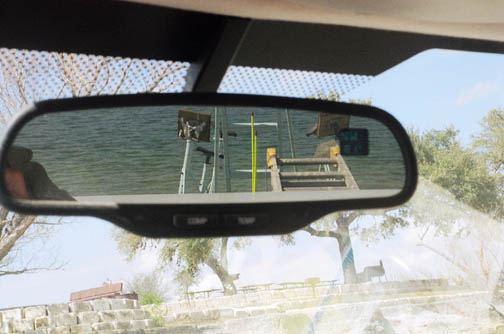 |
|
| It's magic. When the stick falls, I stop and check to see
how I did. Usually I have to move an inch or so foreword or back. |
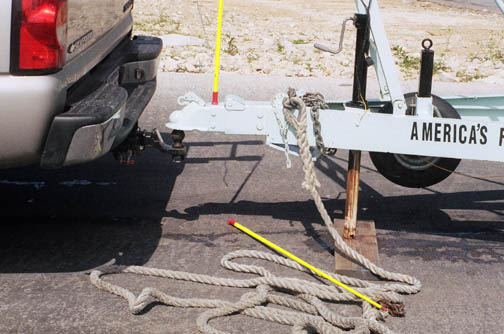 |
Notice the chain on the trailer end of the rope. Trailers
have lots of sharp edges.
A;lthough it would be hard to cut a 1 inch rope, slicing the rope in half
would be tragic.
Regardless, the chain is the only part that touches the metal trailer.
That chain saves us a ton of money on rope. |
| The trailer is all hooked up and ready for the highway.
The jack is fully retracted. The wires for the lights are hooked up. |
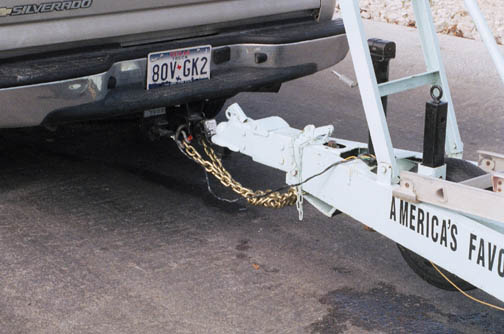 |
Notice how the chains are shortened by twisting. Also notice
how the chains are crossed to form a basket.
The crossed chains will not bind on sharp turns. If you hook up chains
without crossing them, they must be left loose enough for sharp turns.
Safety demands the shortest possible chains. if the latch fails, you want
the trailer to remain close to the vehicle and under your control. |
| |
Home Page
Back to the
Repairs Menu

Since May 10, 2006 |
|














